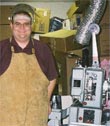|
|
This topic comprises 3 pages: 1 2 3
|
|
Author
|
Topic: white l.e.d.s as a light source
|
|
|
|
|
Matt Hale
Expert Film Handler

Posts: 123
From: Vancouver, Canada
Registered: Dec 2002
|
 posted 03-19-2003 11:20 PM
posted 03-19-2003 11:20 PM





I had envisioned something more on the order of one or two thousand diodes, mounted into the parabolic reflector itself. Exactly how bright this would be with the current technology I dont know, but these new white ones seem a good deal brighter than the red, green & amber ones that have been around for years.
As to bulb replacement, the idea is that you dont need to very often at all. With 2000 light sources, one burnout is only going to diminish your total light ouput by 0.05%. If the light from each individual diode is sufficiently "mixed" with the light from all the others then a burnout is not going to produce a noticable dark spot in the image, just an imperceptable dimming. You could probably run it with quite a few burn-outs, until the image got too dim to be useable, then just replace the whole thing.
Besides, with a rated life of 100,000 hours, thats almost 11.5 years of continuous 24/7/365 operation.
| IP: Logged
|
|
|
|
|
|
Matt Hale
Expert Film Handler

Posts: 123
From: Vancouver, Canada
Registered: Dec 2002
|
 posted 03-20-2003 07:46 PM
posted 03-20-2003 07:46 PM





Well I've done a little more research, and it turns out white leds come in different colour temps. As I recall, 6500k is about the temperature of tungsten light, which is too yellow. I would imagine you could produce the required colour temp by mixing some that are too yellow with some that are too blue. The exact ratio would have to be calculated. Does anybody know what the colour temperature of a xenon bulb is?
The power supply would definitely have to be custom. We're talking about a totally different circuit here, operating on a totally different theory. According to the spec sheet of the 6500k diode, it operates at 3.6v, 20ma. At that spec, 2000 leds would pull 40 amps of current, or about 144 watts of power total. What I still dont know is whether that would be bright enough. 2000 diodes would produce roughly 12,800 candellas. Does anyboady know how many candellas a 1kw xenon puts out?
Cost would be an issue, but I look at it this way:
If a 1kw bulb is available for $386.07 and runs for 2400 hours, it will cost $16,214.94 to get 100,000 hours of xenon light (not counting taxes & shipping.)
If a white led is available for $1.80 (in quantities of 500) then 2000 leds will cost $3,600.00 which leaves plenty to cover the power supply & optics before you even reach half the cost of the xenon.
Am I crazy? (dont answer that.)
| IP: Logged
|
|
|
|
|
|
|
|
Steve Kraus
Film God

Posts: 4094
From: Chicago, IL, USA
Registered: May 2000
|
 posted 03-22-2003 10:54 AM
posted 03-22-2003 10:54 AM



I doubt even 500 would provide the number of lumens required but as to the color issue I think that's a red (hehehe) herring.
Color imaging, whether electronic or photochemical, is based on the fact that the color receptors in the eye (retinal "cones") work on a 3 color basis and we can fool it into seeing colors that are not there. We represent, for example, yellow or cyan as being combinations of green + red or green + blue and we present those colors to the eye and yellow or cyan are perceived by our eyes.
But yellow is NOT a combination of red and green and cyan is NOT a combination of green and blue; they are actual colors--you can describe specific wavelengths of light that are yellow or cyan.
Yet the way our vision works it is not necessary to deliver any actual yellow or cyan or whatever to the eye to have the eye think those colors are there.
So with that in mind I'm not sure that it's necessary to have a continuous spectrum in a projection lamp. I doubt very much that the light emitted by the 3 color phosphors on the CRT I am looking at offer continuous spectra when the 3 combine to form white. A continuous spectra is necessary on photography but not on display.
Without a continuous spectra one might find that, depending on the wavelengths and the density curves of the film, a difference depending on the dyes, that might not be there with a continuous spectrum, like maybe the difference from color positive to IB Technicolor could be more pronounced with this sort of discontinuous illumination than with the continuous light of an arc source but that aside as long as the source is producing the three colors and these colors are properly modulated by the dye image I would expect it to work.
BTW, is a white LED a single LED giving a range of colors or is it really just a closely spaced combination of individual LEDs?
| IP: Logged
|
|
|
|
|
|
|
|
|
|
|
|
|
|
All times are Central (GMT -6:00)
|
This topic comprises 3 pages: 1 2 3
|
Powered by Infopop Corporation
UBB.classicTM
6.3.1.2
The Film-Tech Forums are designed for various members related to the cinema industry to express their opinions, viewpoints and testimonials on various products, services and events based upon speculation, personal knowledge and factual information through use, therefore all views represented here allow no liability upon the publishers of this web site and the owners of said views assume no liability for any ill will resulting from these postings. The posts made here are for educational as well as entertainment purposes and as such anyone viewing this portion of the website must accept these views as statements of the author of that opinion
and agrees to release the authors from any and all liability.
|

 Home
Home
 Products
Products
 Store
Store
 Forum
Forum
 Warehouse
Warehouse
 Contact Us
Contact Us




 Printer-friendly view of this topic
Printer-friendly view of this topic






![[Cool]](cool.gif)

![[Smile]](smile.gif)









